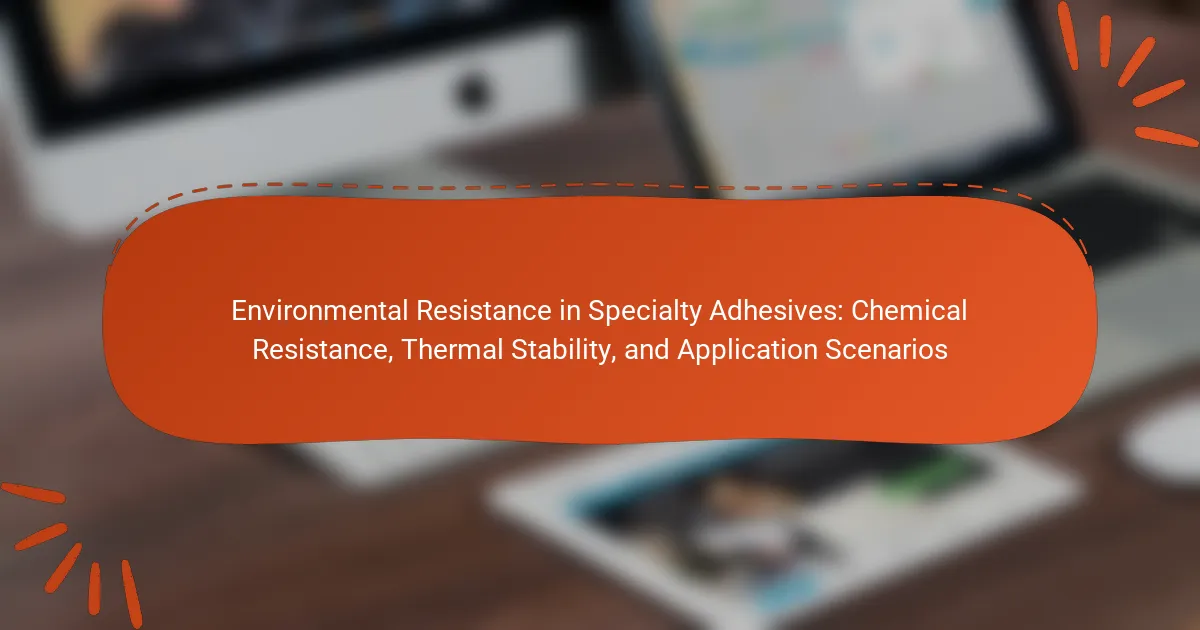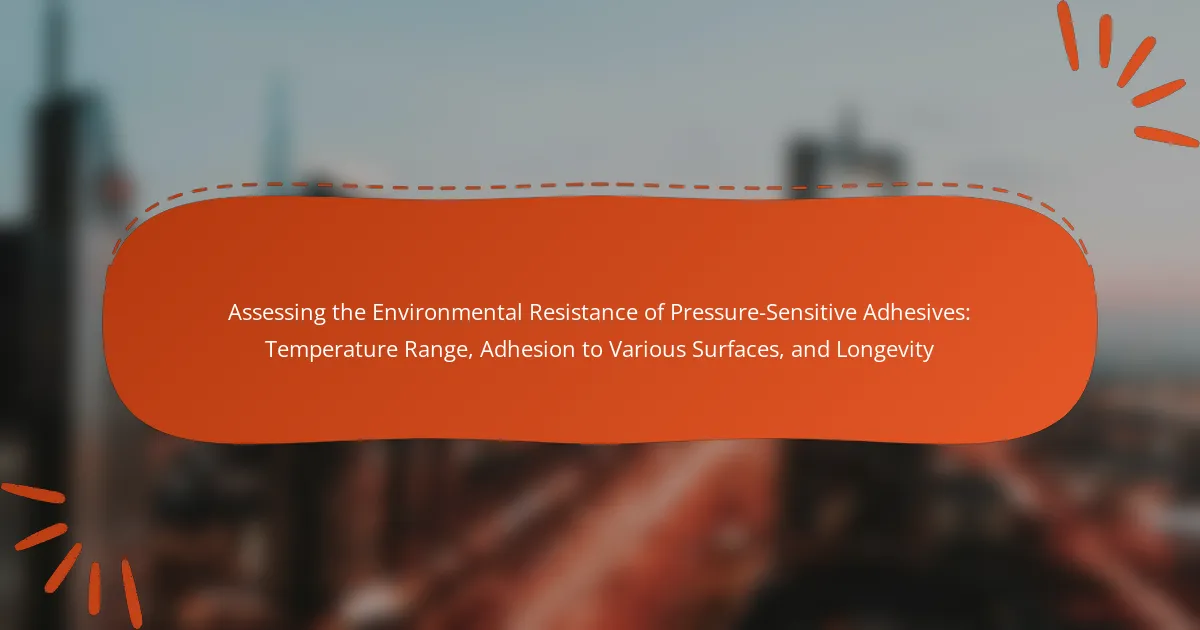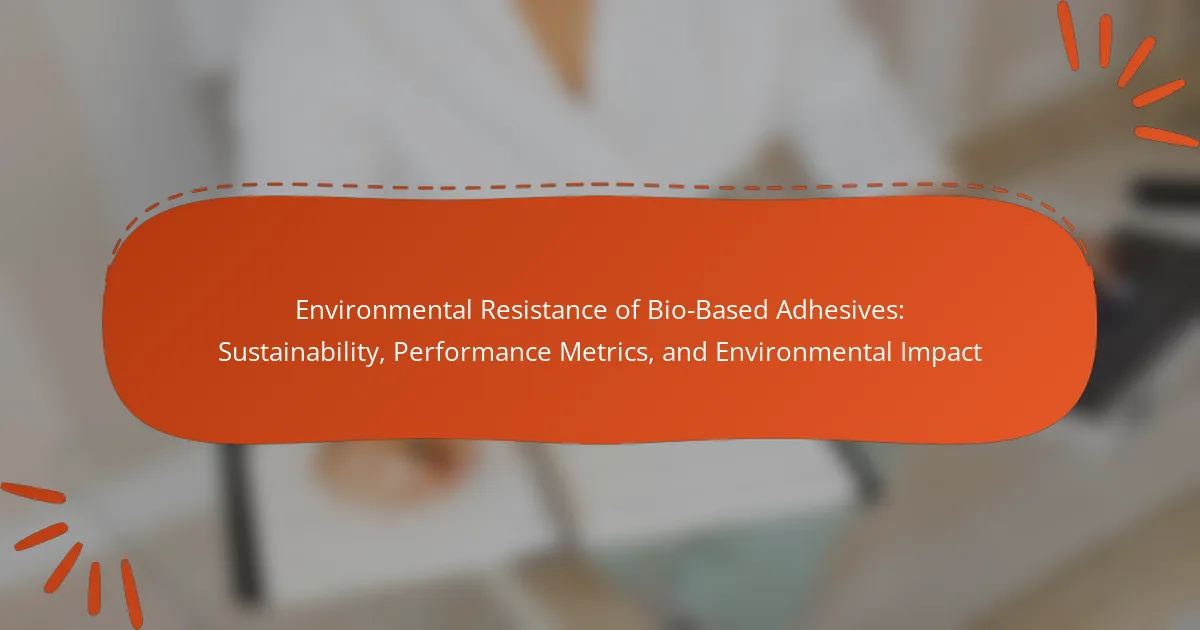Rubber-based adhesives are bonding agents derived from natural or synthetic rubber, recognized for their flexibility and strong adhesion properties. This article examines the environmental resistance of rubber-based adhesives, focusing on three key aspects: temperature tolerance, chemical compatibility, and outdoor durability. Rubber-based adhesives maintain adhesive properties across a wide temperature range, resist degradation from various chemicals, and withstand outdoor elements like UV radiation and moisture. The discussion also highlights advancements in formulations aimed at enhancing these properties, supporting eco-friendly practices in the adhesive industry, and addressing the growing demand for high-performance adhesives.
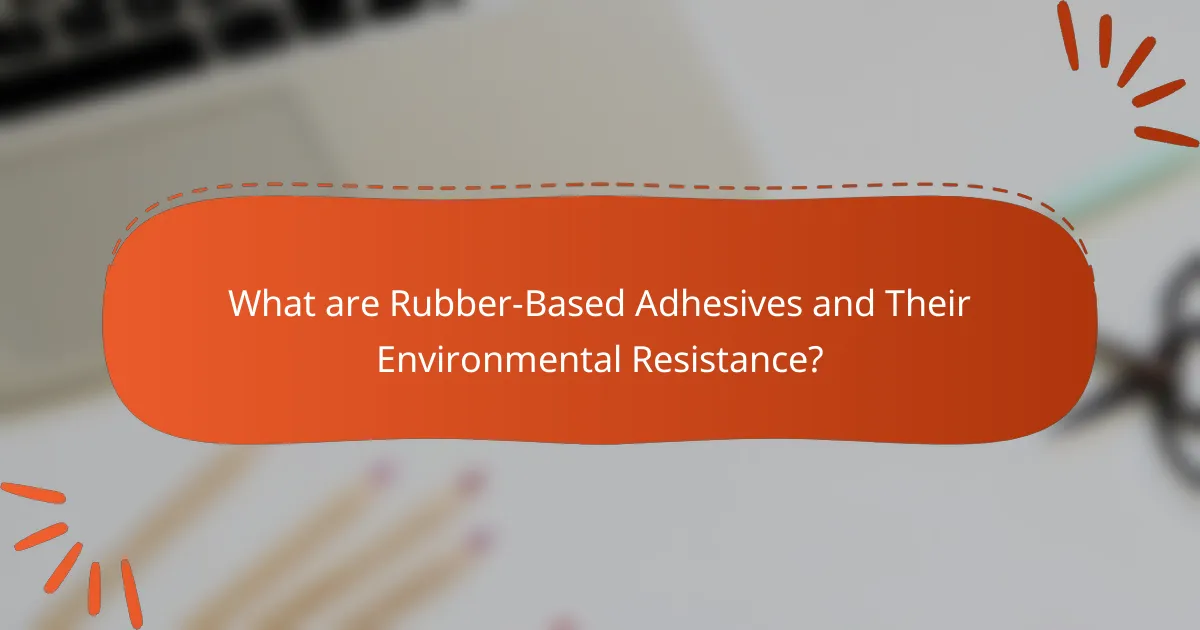
What are Rubber-Based Adhesives and Their Environmental Resistance?
Rubber-based adhesives are bonding agents made primarily from natural or synthetic rubber. They are known for their flexibility and strong adhesion properties. These adhesives exhibit good environmental resistance, particularly in temperature tolerance, chemical compatibility, and outdoor durability.
Temperature tolerance refers to their ability to maintain adhesive properties under varying thermal conditions. Many rubber-based adhesives can perform well in both high and low temperatures, typically ranging from -40°C to 100°C.
Chemical compatibility indicates their resistance to degradation when exposed to various chemicals. Rubber-based adhesives can resist moisture, oils, and some solvents, making them suitable for diverse applications.
Outdoor durability is critical for adhesives exposed to weather elements. Rubber-based adhesives often resist UV radiation and moisture, reducing the risk of failure over time.
In summary, rubber-based adhesives combine flexibility, strong adhesion, and significant environmental resistance, making them ideal for numerous applications.
How do Rubber-Based Adhesives work in various environments?
Rubber-based adhesives function by utilizing the elastic properties of rubber to create strong bonds. They adhere to surfaces through a combination of mechanical interlocking and chemical interactions. In various environments, their performance can vary significantly.
In high-temperature environments, rubber-based adhesives maintain flexibility. This flexibility allows them to withstand thermal expansion without losing adhesion. Conversely, in low temperatures, some formulations may become brittle, affecting bond strength.
Chemical compatibility is crucial for rubber-based adhesives. They can resist moisture and certain chemicals, but exposure to solvents may weaken the bond. Each adhesive formulation has specific resistance levels to different chemicals.
Outdoor durability is another important aspect. Rubber-based adhesives can endure UV exposure, but prolonged sunlight may degrade some types. Weather resistance varies based on the specific rubber compound used.
Overall, rubber-based adhesives adapt to different environments through their unique properties. Their effectiveness is determined by factors such as temperature, chemical exposure, and environmental conditions.
What are the key components of Rubber-Based Adhesives?
Rubber-based adhesives primarily consist of elastomers, tackifiers, and solvents. Elastomers provide flexibility and adhesion properties. Common elastomers include natural rubber and synthetic rubber types like styrene-butadiene rubber. Tackifiers enhance the stickiness of the adhesive. They improve the adhesive’s performance on various substrates. Solvents are used to dissolve the elastomers and facilitate application. They also affect the drying time and viscosity. The combination of these components determines the adhesive’s overall performance and environmental resistance.
How do these components contribute to environmental resistance?
Rubber-based adhesives exhibit environmental resistance through their temperature tolerance, chemical compatibility, and outdoor durability. Temperature tolerance allows these adhesives to maintain performance in extreme heat and cold. This characteristic prevents degradation and maintains adhesion strength under varying climate conditions. Chemical compatibility ensures that rubber-based adhesives can withstand exposure to solvents and harsh chemicals without losing integrity. This resistance minimizes the risk of bond failure in industrial and outdoor applications. Outdoor durability contributes by enhancing resistance to UV light and moisture, which can otherwise weaken adhesive bonds. Together, these components create a robust adhesive that performs reliably in diverse environments.
What factors influence the temperature tolerance of Rubber-Based Adhesives?
The temperature tolerance of rubber-based adhesives is influenced by several factors. These factors include the type of rubber used in the formulation. Different rubber compounds have varying thermal properties. The presence of additives, such as plasticizers and fillers, can also affect temperature resistance. The curing process plays a critical role in determining the final properties of the adhesive. Additionally, the formulation’s viscosity impacts how the adhesive behaves under temperature changes. Environmental conditions, such as humidity and exposure to UV light, can further influence temperature tolerance. Understanding these factors is essential for selecting the appropriate rubber-based adhesive for specific applications.
How does temperature affect the performance of Rubber-Based Adhesives?
Temperature significantly affects the performance of rubber-based adhesives. Higher temperatures can reduce the viscosity of the adhesive, leading to easier application and better flow. However, excessive heat can also cause degradation of the adhesive, resulting in a loss of bond strength. Low temperatures can increase the viscosity, making application more difficult. Cold conditions may also lead to brittleness, which compromises the adhesive’s ability to maintain a strong bond. Studies show that rubber-based adhesives have optimal performance within specific temperature ranges. For instance, many formulations perform best between 20°C and 30°C. Outside this range, performance can decline rapidly, affecting adhesion and durability.
What are the temperature limits for effective use of Rubber-Based Adhesives?
Rubber-based adhesives are effective within a temperature range of -30°F to 200°F (-34°C to 93°C). Below -30°F, the adhesive may lose its bonding strength. Above 200°F, the adhesive can degrade, leading to failure in adhesion. This temperature tolerance is crucial for applications in diverse environments. Many manufacturers provide specific guidelines that confirm these limits. For instance, products often specify optimal performance within this range to ensure reliability.
What is the significance of chemical compatibility in Rubber-Based Adhesives?
Chemical compatibility in rubber-based adhesives is crucial for ensuring optimal performance and longevity. It determines how well the adhesive interacts with various substances, including solvents, oils, and other materials. Incompatible chemicals can lead to degradation, weakening the adhesive bond. This degradation can result in reduced adhesion strength and premature failure of the bonded assembly.
Studies indicate that rubber-based adhesives often contain specific formulations that enhance their resistance to chemicals. For instance, the presence of certain additives can improve compatibility with aggressive solvents. This compatibility is particularly significant in applications exposed to harsh environments, such as automotive or industrial settings.
Research shows that assessing chemical compatibility can extend the service life of adhesive applications. Proper evaluation helps in selecting the right adhesive for specific environmental conditions. This leads to better performance and reliability in practical use.
Which chemicals are commonly tested for compatibility with Rubber-Based Adhesives?
Common chemicals tested for compatibility with rubber-based adhesives include solvents, oils, and fuels. Specific solvents like toluene and acetone are often evaluated. Oils such as mineral oil and vegetable oil are also tested. Fuels including gasoline and diesel are considered for compatibility assessments. These chemicals can affect the adhesive’s performance and longevity. Testing ensures that the adhesive maintains its bond under various conditions. Compatibility testing is crucial for applications in automotive and industrial settings.
How does chemical exposure impact the integrity of Rubber-Based Adhesives?
Chemical exposure can significantly degrade the integrity of rubber-based adhesives. Prolonged contact with solvents, oils, or acids can lead to swelling, softening, or complete dissolution of the adhesive. This degradation compromises the adhesive’s bond strength and performance. For instance, exposure to acetone can weaken the adhesive bond by breaking down its polymer structure. Studies have shown that certain chemicals can reduce adhesion by over 50% in less than 24 hours. Furthermore, the presence of moisture can exacerbate chemical effects, leading to hydrolysis of the adhesive components. Therefore, chemical compatibility is crucial for maintaining the integrity of rubber-based adhesives in various applications.
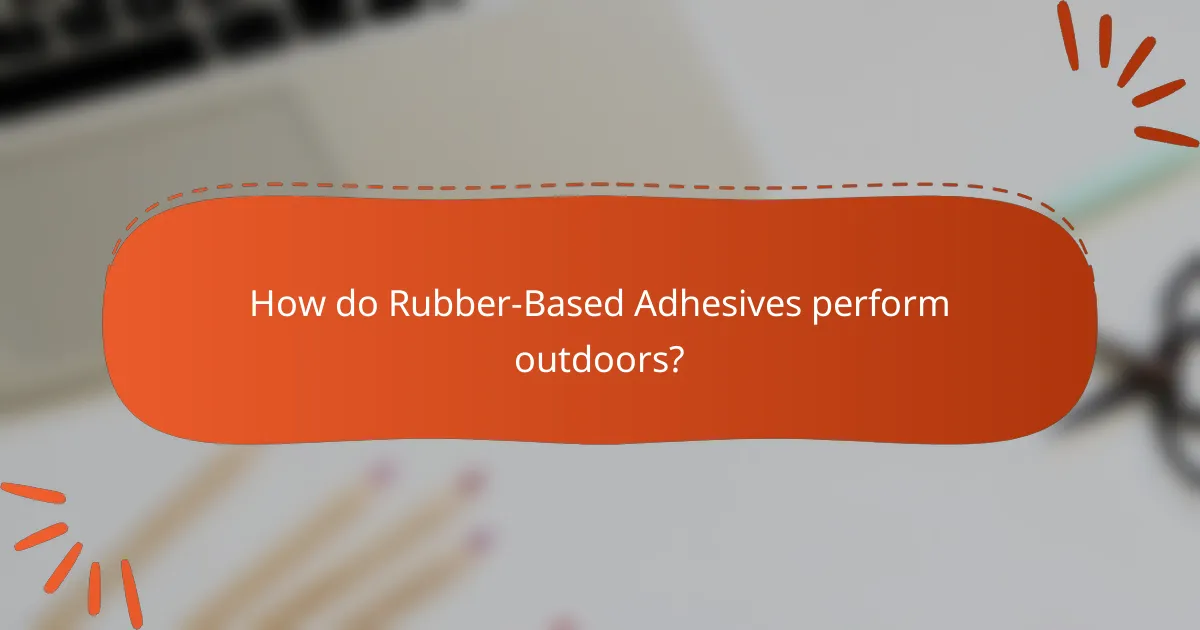
How do Rubber-Based Adhesives perform outdoors?
Rubber-based adhesives generally perform well outdoors. They exhibit strong adhesion to various surfaces, maintaining bond integrity in outdoor conditions. Their flexibility allows them to withstand temperature fluctuations without cracking. Additionally, rubber-based adhesives have good resistance to moisture and UV exposure. This makes them suitable for applications like sealing and bonding in construction and automotive industries. Studies indicate that they can maintain performance for extended periods when properly applied. For instance, some formulations resist degradation for over five years under outdoor conditions.
What are the key attributes of outdoor durability in Rubber-Based Adhesives?
The key attributes of outdoor durability in rubber-based adhesives include weather resistance, UV stability, temperature tolerance, and moisture resistance. Weather resistance ensures that the adhesive can withstand rain, snow, and wind without losing its bonding strength. UV stability protects the adhesive from degradation caused by sunlight exposure, which can lead to brittleness and loss of adhesion. Temperature tolerance allows the adhesive to maintain performance in extreme heat or cold, ensuring it remains functional in varying climates. Moisture resistance prevents water absorption, which can weaken the bond over time. These attributes are critical for applications exposed to outdoor elements, ensuring long-lasting performance and reliability.
How do environmental factors like UV light and moisture affect Rubber-Based Adhesives?
Environmental factors like UV light and moisture significantly affect rubber-based adhesives. UV light can cause degradation of the adhesive’s polymer structure. This degradation leads to loss of strength and adhesion over time. Moisture can also weaken rubber-based adhesives. It may cause hydrolysis, which breaks down the adhesive bond.
Research indicates that prolonged exposure to UV light can reduce the lifespan of rubber-based adhesives by up to 50%. Additionally, moisture can lead to swelling and softening of the adhesive, compromising its effectiveness. These environmental factors must be considered when selecting rubber-based adhesives for outdoor applications.
What are the common applications requiring outdoor durability of Rubber-Based Adhesives?
Common applications requiring outdoor durability of rubber-based adhesives include construction, automotive assembly, and outdoor signage. In construction, these adhesives bond materials like roofing membranes and insulation. Automotive assembly uses them for weatherstripping and interior components exposed to the elements. Outdoor signage benefits from their strong adhesion and resistance to UV light and moisture. Additionally, rubber-based adhesives are utilized in marine applications for bonding various materials in boats and other watercraft. Their ability to withstand temperature fluctuations and harsh weather conditions makes them ideal for these uses.
What best practices can enhance the environmental resistance of Rubber-Based Adhesives?
Best practices to enhance the environmental resistance of rubber-based adhesives include selecting high-quality, weather-resistant formulations. These formulations often contain additives that improve UV stability and hydrolytic resistance. Proper surface preparation is crucial; clean and dry surfaces ensure better adhesion and longevity. Applying adhesives at optimal temperatures enhances curing and performance. Additionally, using protective coatings can shield adhesives from harsh environmental factors. Regular testing for chemical compatibility with substrates can prevent degradation. Finally, following manufacturer guidelines for storage and application can significantly extend the adhesive’s effectiveness.
How should Rubber-Based Adhesives be applied for optimal performance?
Rubber-based adhesives should be applied to clean, dry surfaces for optimal performance. Ensure that the application area is free from dust, grease, and moisture. Use a suitable applicator, like a brush or roller, to spread the adhesive evenly. Apply the adhesive in a consistent layer to avoid weak spots. For best adhesion, allow the adhesive to reach its open time before joining surfaces. This typically ranges from a few minutes to several hours, depending on the product. After application, apply pressure to ensure a strong bond. Proper curing time is essential for maximum strength. Most rubber-based adhesives achieve full bond strength within 24 hours.
What maintenance tips ensure long-lasting durability of Rubber-Based Adhesives?
To ensure long-lasting durability of rubber-based adhesives, store them in a cool, dry place. High temperatures can degrade adhesive properties. Maintain a consistent temperature to prevent moisture absorption. Clean surfaces before application to enhance bonding strength. Avoid exposure to harsh chemicals that can weaken the adhesive. Regularly inspect bonded areas for signs of wear or damage. Reapply adhesive as needed to maintain integrity. Following these practices can extend the lifespan of rubber-based adhesives significantly.
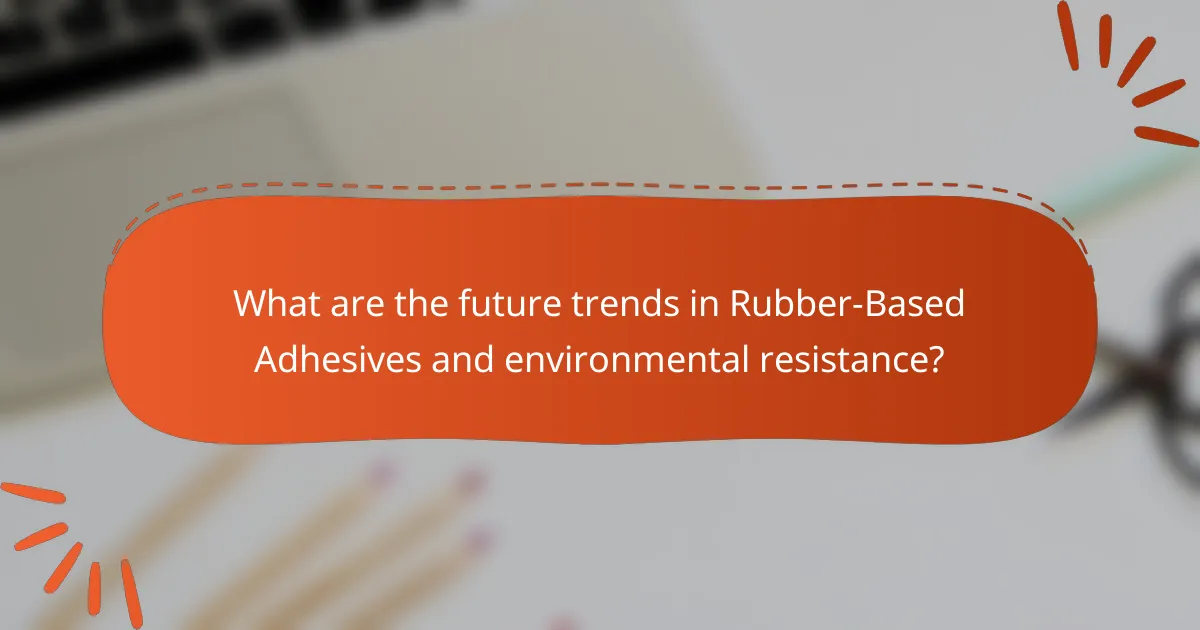
What are the future trends in Rubber-Based Adhesives and environmental resistance?
Future trends in rubber-based adhesives focus on enhancing environmental resistance. Innovations aim to improve temperature tolerance and chemical compatibility. Manufacturers are developing formulations that withstand extreme weather conditions. These advancements will lead to increased outdoor durability. Sustainable materials are being integrated into adhesive production. This shift supports eco-friendly practices in the adhesive industry. Research indicates a growing demand for high-performance, resilient adhesives. The focus on environmental resistance aligns with industry standards and consumer preferences.
How is technology advancing the development of more resilient Rubber-Based Adhesives?
Technology is advancing the development of more resilient rubber-based adhesives through innovations in formulation and processing techniques. New materials, such as high-performance polymers, enhance adhesion properties and durability. Advanced additives improve temperature tolerance and chemical resistance. Innovations in nanotechnology allow for the incorporation of nanoparticles, which increase strength and flexibility. Furthermore, digital modeling and simulation techniques enable precise formulation adjustments. These advancements lead to adhesives that perform better under extreme environmental conditions. Research indicates that modern rubber-based adhesives can withstand a wider range of temperatures and harsh chemicals compared to traditional formulations.
What innovations are emerging in the formulation of Rubber-Based Adhesives?
Emerging innovations in the formulation of rubber-based adhesives include the use of bio-based materials. These materials enhance environmental sustainability while maintaining performance. Advanced polymer technologies are also being developed to improve temperature tolerance and chemical compatibility. Innovations such as nano-fillers are incorporated to enhance durability and adhesion properties. Additionally, formulations are increasingly designed to be solvent-free, reducing environmental impact. Research indicates that these advancements significantly improve outdoor durability and performance in extreme conditions. For instance, a study published in the Journal of Adhesion Science and Technology highlighted the effectiveness of these new formulations in harsh environments.
How do these innovations address current challenges in environmental resistance?
Innovations in rubber-based adhesives enhance environmental resistance by improving temperature tolerance and chemical compatibility. These advancements allow adhesives to perform effectively in extreme temperatures, ranging from -40°C to 120°C. Enhanced chemical compatibility ensures that adhesives resist degradation when exposed to various solvents and chemicals.
For instance, recent formulations incorporate modified polymers that withstand harsh outdoor conditions. This results in longer-lasting bonds and reduced failure rates in applications exposed to moisture and UV radiation. Studies indicate that these innovations can extend the lifespan of adhesive applications by up to 50%.
Overall, these developments effectively mitigate challenges related to environmental resistance, ensuring reliable performance across diverse conditions.
What are the common troubleshooting tips for users of Rubber-Based Adhesives?
Common troubleshooting tips for users of rubber-based adhesives include ensuring proper surface preparation. Clean surfaces should be free of dust, grease, and moisture. Users should also apply the adhesive evenly to avoid weak spots. Allow adequate curing time as specified by the manufacturer. If the bond fails, check for temperature extremes that may affect adhesion. Additionally, verify the compatibility of the adhesive with the materials being bonded. If the adhesive does not set properly, humidity levels may need to be assessed. Finally, users should store adhesives in a cool, dry place to maintain their effectiveness.
How can users identify and resolve issues related to temperature tolerance?
Users can identify issues related to temperature tolerance by monitoring adhesive performance under varying temperatures. Signs of temperature tolerance issues include softening, hardening, or loss of adhesion. Users should conduct tests at different temperatures to observe changes in adhesive properties. For resolution, selecting adhesives specifically rated for temperature resistance can improve performance. Additionally, applying adhesives within the manufacturer’s recommended temperature range is crucial. Research indicates that rubber-based adhesives can degrade outside their optimal temperature limits, leading to failure. Proper storage and handling can also mitigate temperature-related issues.
What steps can be taken if chemical incompatibility is suspected?
If chemical incompatibility is suspected, the first step is to identify the chemicals involved. This can involve consulting safety data sheets (SDS) for each substance. Next, isolate the chemicals to prevent any reactions. Proper personal protective equipment (PPE) should be worn throughout the process. Conduct compatibility testing in a controlled environment if possible. Observe for any signs of reaction, such as color change or temperature variation. Dispose of incompatible materials according to local regulations. Document all findings for future reference. These steps help ensure safety and prevent hazardous incidents.
Rubber-based adhesives are bonding agents primarily composed of natural or synthetic rubber, known for their flexibility and strong adhesion. This article explores their environmental resistance, focusing on temperature tolerance, chemical compatibility, and outdoor durability. Key components such as elastomers, tackifiers, and solvents contribute to their performance under various conditions. Additionally, best practices for application and maintenance are discussed, along with future trends in adhesive formulation aimed at enhancing resilience against environmental factors.

